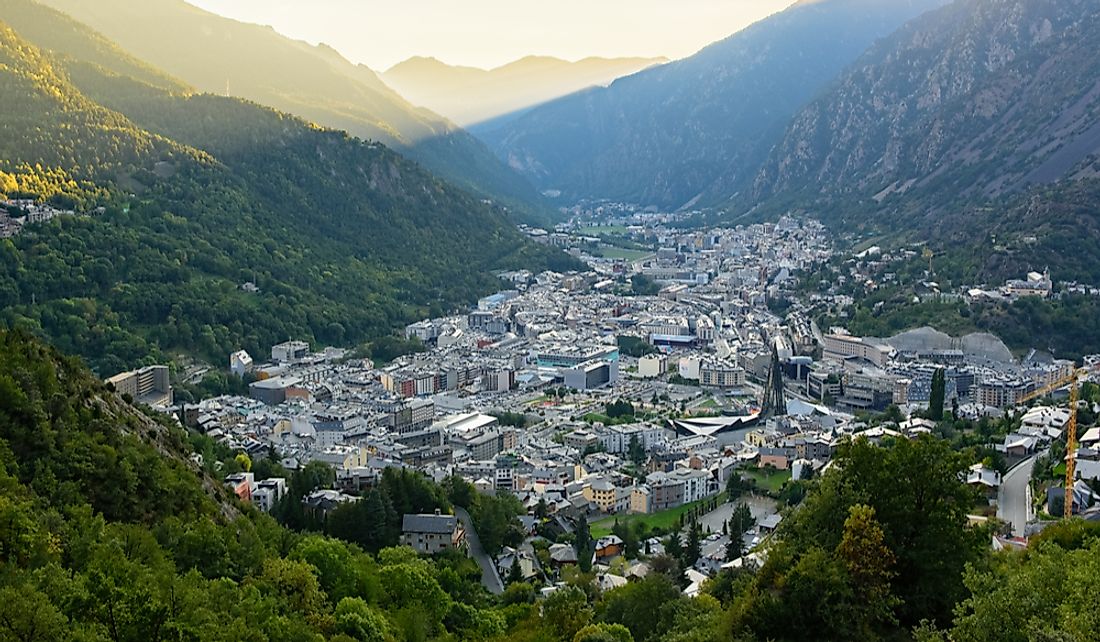What Type Of Climate Does Andorra Have?

Andorra is a small European country situated on the southern peaks of the Pyrenees Mountains. It is bordered to the south and west by Spain and to the north and east by France. The capital city of Andorra is Andorra La Vella. The country's landscape is characterized by steep valleys, glacial landscapes, and open pastures. Andorra lies at an average altitude of 6,200 feet above sea level meaning it has the highest average elevation in Europe. Andorra La Vella is situated at an altitude of 3,300 feet above sea level while the lowest point in the state is the Sant Julia de Loria close to the border with Spain which is at an elevation of 2,755 feet above sea level. Coma Pedrosa is the highest point in the country at an elevation of 9,652 feet above sea level. The varying elevation greatly impacts the country's climate.
Climate
The country has a mountain climate in the high altitude and temperate climate in the lower valley. Precipitation is moderate averaging between 30 and 35 inches per year. Air masses carrying moisture from the Mediterranean Sea and the Atlantic Ocean rise over the Pyrenees providing lifting and the resulting precipitation. Precipitation occurs quite often due to the Atlantic frontal systems that influence conditions in the country for several months. During winter precipitation occurs in the form of snow beginning in November and ending in Late March or early April. The winter snow is vital for the tourism industry with the country providing some of the best skiing in the Pyrenees. During the summer the Azores anticyclone is experienced, and thunderstorms may occur in the afternoons. In January the temperatures get to an average of 36.5 degrees Fahrenheit while the temperature in July and August are about 66 degrees Fahrenheit. The winters are cold but not freezing but the temperatures during the night sometimes drop a few degrees below freezing point. Wind with foehn-like characteristics which is dry and warm blows from the north. The country may occasionally experience heavy snowfall and frosts. Summers in the country are quite warm during the day with temperatures reaching highs of 77 degrees Fahrenheit while the temperatures during the night are cool. Thunderstorms may occur in the afternoons.
Seasonal Changes
Spring
The weather in spring is conducive for skiing until mid-April with temperatures becoming quite high by the end of the month. A humid and windy spring is experienced in May. The average temperatures during the season are about 50 degrees Fahrenheit with May being the warmest in the season with average temperatures of 59 degrees Fahrenheit. Those who prefer activities other than skiing can visit the country during this time.
Summer
Summers in the country are mild to warm with clear skies and bright sunshine. The temperatures are relatively warm with averages of 77 degrees Fahrenheit. Summer is a favorable time for excursions.
Autumn
Autumn has pleasant weather conditions. The rains start in October and are followed by snow in November. The average temperatures during the season range between 41 to 50 degrees Fahrenheit. As the season approaches the end, frost during the night is experienced. Visits in the first two months of the season can be dedicated to summer like activities while towards the end of the season one can begin to experience skiing. Dog lead ridding is a popular activity in the country.
Winter
Winters are cold but not harsh except at the highest elevations. The country's winters have snow, cold nights and lots of sunshine. Severe frosts are not experienced, and the wet snow is ideal for skiing. Winter is, therefore, the peak season for tourists from Europe who flock to the country to ski. The country has many ski resorts and zones that visitors can enjoy as well as all kinds of related winter activities. During December and January, the temperatures drop to 32 degrees Fahrenheit.
Andorra La Vella
The months with the highest average maximums temperatures are June, July, August, and September with 73, 79, 75, and 72 degrees Fahrenheit respectively. Precipitation in the capital city is estimated to be about 32 inches per year. The precipitation is generally well distributed throughout the year with a relative minimum in winter and early spring. May and June are the rainiest with an average of 3.5 and 3.3 inches of rainfall per year which is associated with afternoon thunderstorms. The months of February and March have the lowest precipitation with 1.2 and 1.6 inches of average precipitation per year.
Soldeu
Soldeu is situated at an elevation of 5,900 feet above sea level. The climate is colder compared to Andorra La Vella with average temperatures reaching a minimum of 26.5 degrees Fahrenheit and average maximum temperatures reaching 53.5 degrees Fahrenheit. The average precipitation is about 51 inches per year. Dry seasons are not experienced because thunderstorms occur in the afternoon during summer.
When To Visit
One can visit Andorra all year round depending on the activities one is interested. During June to mid-September, conditions in the valley are warm, and the mountains experience the least cold in the year. One should also expect cool temperatures in the night in the valley region and cold conditions at higher altitudes. Afternoon thunderstorms should also be expected. The warmest months are July and August with July experiencing fewer thunderstorms compared to August. Those who are interested in winter sports such as skiing are advised to visit during the winter months of December, January, and February.











